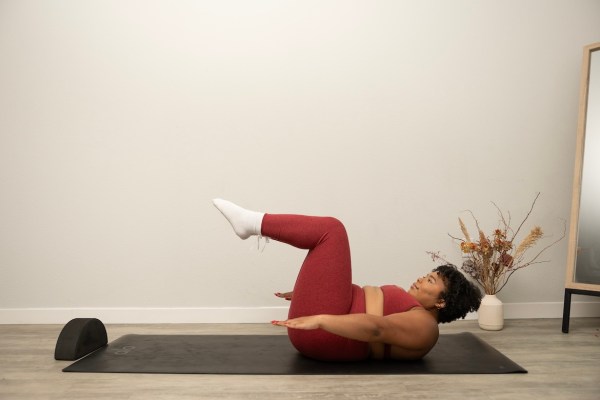Let’s be trustworthy: There’s a “stereotypical physique†downside in Pilates—although any physique that does this train is certainly a Pilates physique.
When you’re a newbie, don’t match the stereotypical Pilates physique sort, or have a bodily limitation that retains you from doing a normal model of a transfer, there ought to be no embarrassment in making the right Pilates modifications. Sadly, mat Pilates teacher Angell Foster typically sees shoppers really feel shameful about it.
“I want we may cease viewing needing to switch with ‘not being sturdy sufficient,’†Foster says. “Modifying doesn’t imply the transfer is not troublesome. It simply permits you the chance to entry the transfer with correct type that received’t trigger damage.â€
Though offering completely different choices for actions ought to be the usual for any health class or skilled, Foster provides that that is typically not the case. That’s what leaves many individuals to really feel excluded from Pilates and different health routines.
“Pilates has been such an incredible motion apply for me due to the way in which it challenges my physique,†Foster says. “There are some strikes that I can not entry within the conventional sense primarily based on my physique sort—however that doesn’t imply I ought to be excluded.â€
And neither do you have to: When you discover basic Pilates strikes inaccessible, strive these Pilates modifications from Emily Kucharczyk, reformer Pilates program lead at Match Athletic Membership, and demonstrated by Foster.
“I want we may cease viewing needing to switch with ‘not being sturdy sufficient.’ Modifying doesn’t imply the transfer is not troublesome. It simply permits you the chance to entry the transfer with correct type that received’t trigger damage.†—Angell Foster, Pilates teacher
1. The hundred modification: Hundred with bent knees
Though the hundred is a basic Pilates transfer, holding your legs totally prolonged will be difficult. This variation reduces pressure in your decrease again whereas nonetheless delivering the core engagement the transfer is thought for.
“It’s nice for inexperienced persons who’re studying to correctly interact their stomach muscle tissue,†Kucharczyk says. “People who’ve longer legs, relative to their torso, will even get much less pull from their decrease again.â€
As a result of it minimizes stress in your backbone, this modification can also be ultimate for these with decrease again ache or tight hip flexors.

- Begin by mendacity in your again, knees bent, ft flat on the ground, and arms lengthy at your sides.
- Take a deep breath in. In your exhale, concentrate on contracting your intercostal muscle tissue (muscle between your ribs) whereas drawing your ribs down and into the ground, pulling your again flat to the mat.
- Raise one leg at a time as much as the tabletop place. Maintain your knees bent at 90 levels, shins parallel to the ground.
- Take a deep breath in. In your exhale, raise your head, neck, and shoulders off the mat whereas extending your arms ahead.
- Pump your arms up and down whereas inhaling for 5 counts and exhaling for 5 counts, sustaining regular, managed breaths.
- Repeat this sample, aiming for a complete of ten full breaths. This may deliver you to a complete of 100 arm pumps.
2. Plank modification: Kneeling plank
The plank is a strong transfer for core and upper-body energy, however it may be overwhelming for those who’re simply beginning out or have wrist or shoulder issues. This kneeling variation reduces the load in your wrists and shoulders and lowers the general depth of the transfer, whereas nonetheless difficult your core.
“It makes it simpler to keep up correct alignment with out collapsing within the decrease again,†Kucharczyk says. “It helps these with much less upper-body energy or who could wrestle with steadiness in a full plank.â€

- Start on all fours along with your wrists aligned beneath your shoulders and knees beneath your hips.
- Stroll your arms ahead barely, permitting your hips to fall in a straight line out of your shoulders.
- Take a deep breath in, and in your exhale, draw your ribs down and in to contract the muscle tissue between your ribs. Maintain the connection to your rib muscle tissue whereas persevering with to take sluggish, regular, deep, and full breaths out and in.
- Whereas holding your core engaged, maintain the place for the specified size of time, holding your again from arching or rounding and shoulders away out of your ears.
3. Shoulder bridge modification: Supported shoulder bridge with a block or ball between your knees
Whereas the shoulder bridge is a unbelievable manner to enhance your core stability, glute energy, and total lower-body conditioning (whereas additionally selling spinal flexibility and mobility!), not everybody can do that train with out discomfort of their decrease again and hamstrings.
“By performing this modification, the decrease again has help, making it simpler to raise your hips and maintain the place with correct alignment,†Kucharczyk says. “The shoulder bridge is a good train for all our bodies, particularly those that have a tougher time partaking their glutes.â€
Having a ball or block between the knees additionally helps your pelvic flooring activate—and permits the pinnacle of your femur (the thigh bone) to be positioned extra laterally from the hip socket, which boosts the consolation degree to your decrease again.

- Lie in your again along with your knees bent and ft flat on the ground, hip-width distance aside. Maintain your arms resting at your aspect, palms dealing with down.
- Place a ball or tender yoga block between your thighs.
- Take a deep breath in, then on the exhale, draw your ribs muscle tissue down and in towards the mat, making a flat again.
- Take one other deep breath in, and on this exhale, start to raise your hips off the ground. As you raise, press into your ft and have interaction your glutes and hamstrings, sustaining a flat again.
- Maintain the bridge on the high for a second and decrease your self again right down to the ground slowly. As you proceed to raise and decrease, drive your knees ahead and pull your heels towards your backside.
- Proceed this train for the specified variety of repetitions, specializing in fluidity and management, whereas partaking the entrance and bottom of your physique.
4. Single-leg stretch modification: Single-leg stretch with head help
These with neck ache, a bigger chest, or who’re inexperienced persons will profit from this modification as a result of it reduces neck pressure and permits for better concentrate on deep core engagement.
“Purchasers typically pull from their neck, slightly than lifting the chest off the ground from deep core muscle tissue,†Kucharczyk says. “Supporting your head with a small pillow or folded towel retains the neck relaxed, permitting you to concentrate on partaking your core with out pointless pressure.â€
This modification is an effective way to ease into the train, whereas nonetheless sustaining correct alignment.

- Lie in your again along with your knees bent and ft flat on the ground. Place a small pillow or folded towel beneath your head for help.
- Raise one leg at a time to the tabletop place, along with your knees at a 90-degree angle and shins parallel to the ground. Carry your arms to the knee that is in tabletop place.
- Interact your core by contracting your rib muscle tissue, pulling your stomach in towards your backbone.
- Inhale as you draw your proper knee towards your chest, inserting your proper hand in your proper shin and your left hand in your proper knee. Concurrently, prolong your left leg out at a 45-degree angle (or increased, if wanted, to keep up core stability).
- Exhale as you turn legs, bringing your left knee towards your chest, inserting your left hand in your left shin, and inserting your proper hand in your left knee. Lengthen the fitting leg out on the identical time.
- Proceed alternating legs in a clean, managed rhythm. Enable your head to loosen up into the pillow or folded towel, whereas sustaining a connection from the decrease again to the ground and holding your rib muscle tissue engaged.
- Direct your breaths into your decrease again, slightly than increasing via your abdomen, and proceed the train for the specified variety of repetitions.
5. Backbone stretch ahead modification: Seated backbone stretch with elevated hips
This elementary Pilates motion helps you with flexibility, correct posture, and core energy. It encourages lengthening via your backbone and may counteract the results of slumping or rounded shoulders.
“Nevertheless, attaining a deep stretch within the backbone whereas holding your legs straight will be troublesome, particularly when you’ve got tight hamstrings or accidents to the decrease again,†Kucharczyk says.
Elevating your hips with a cushion or blanket helps you keep straighter legs, permitting for a more practical and cozy stretch.

- Sit on the mat along with your legs prolonged and barely wider than hip-width distance aside.
- Place a folded blanket or small cushion beneath your hips to raise them.
- Attain your arms ahead at shoulder top. Take a deep breath in and as you exhale gently, drawing your ribs in towards your backbone and interesting your core muscle tissue.
- Holding your shoulders relaxed and away out of your ears, inhale to organize. In your subsequent exhale, start to roll your backbone ahead, beginning along with your head—then neck, higher again, mid-back, and decrease again.
- Proceed to succeed in towards your toes, ideally with flexed ft (you’ll be able to level your toes when you’ve got discomfort in your calves, hamstrings, or decrease again). Deal with sustaining a protracted backbone and keep away from collapsing out of your chest.
- Maintain the stretch at your furthest level and inhale deep into your decrease again, feeling your again develop. Exhale to see for those who can deepen the stretch barely with out forcing your self ahead.
- Inhale as you start to roll your backbone again up one vertebra at a time, stacking your backbone starting at your decrease, mid, after which higher again like a slinky.
- Proceed the train for desired repetitions, specializing in fluidity and management with every motion.

